The perfect opening line examples for your next LinkedIn post




If you want more people to read your LinkedIn post then your first line is what you must master.
What determines the success of your content on LinkedIn? Everyone has different measures based on their LinkedIn goals but one thing that's constant is that your audience should actually read your content. And not just scroll past it. So, how do you make sure your audience gets curious with your first line, stops, clicks "...see more" to expand your post and continues reading?
"You write an opening line that hooks your reader to your post. You trigger curiosity and they click “...see more” "
The first line of your post is what decides if you have been able to capture the attention of your audience or not. That is what decides if the reader will actually be curious enough to continue reading.
In this article you will find 10 real examples of posts with great opening lines. Think of these as frameworks and try to test them in your next post.
1. A Big Number
This is the oldest trick in the book.
If you’re looking to get your audience interested in what you have to say, start with providing a “hook”. One of the easiest ways to achieve this: find a relevant and eye-catching statistic that makes your audience stop scrolling.
James Roycroft-Davis applies this with his post below.
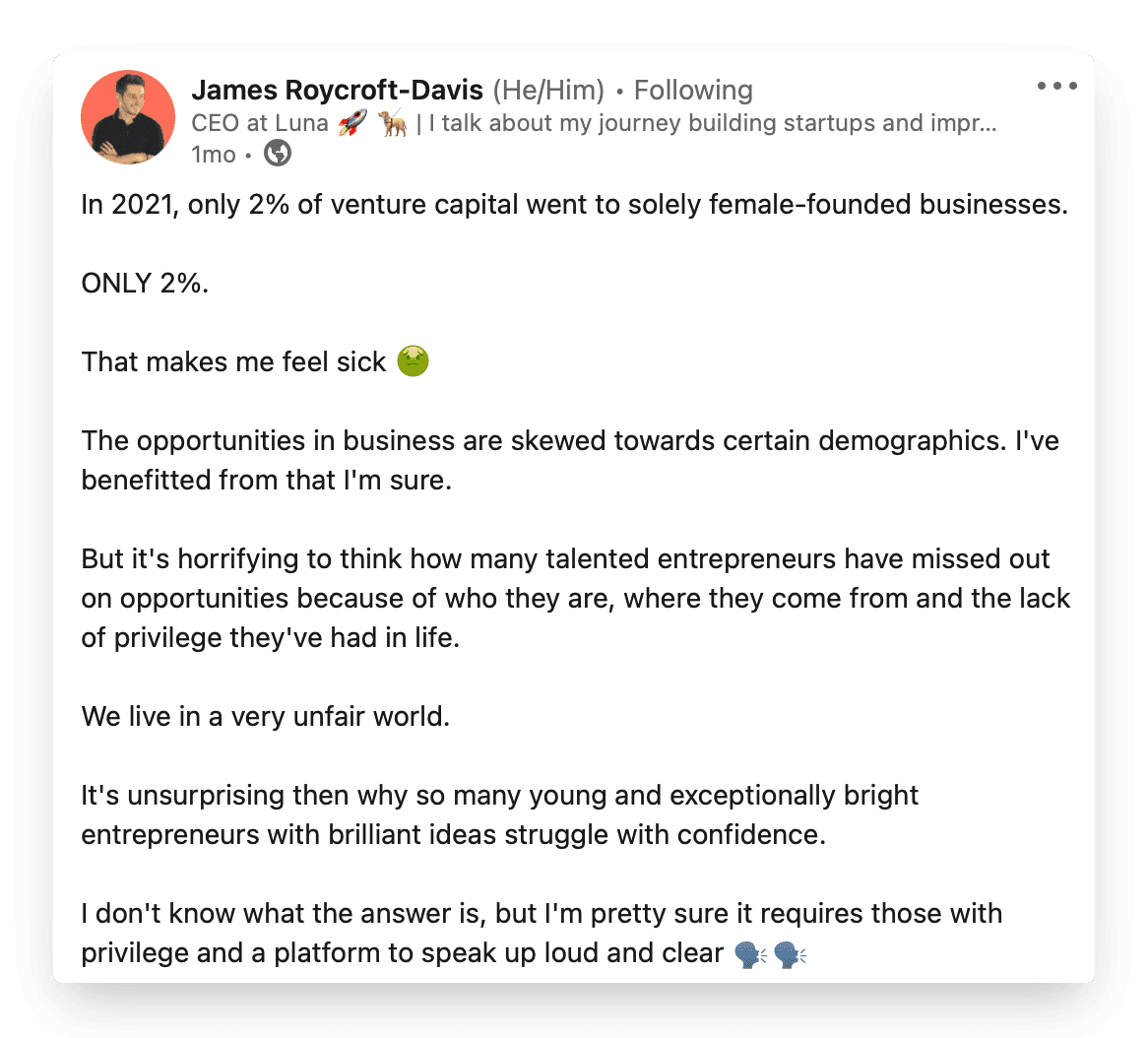
Of course, dropping an eye-catching number in your opening line isn’t enough; you’ll need to follow with your opinions, experiences and everything in between to deliver the impact of said number!
2. The "How to Guide”
More often than not, your audience will follow you because of the value you provide, whether that comes in the forms of your expertise, experiences, or something else entirely.
Great. So shine a light on this from the onset. Write an opening line that highlights what your audience is going to gain from your post.
For listicle content like the post below, this is simple case of writing ‘Here’s how to XYZ’.
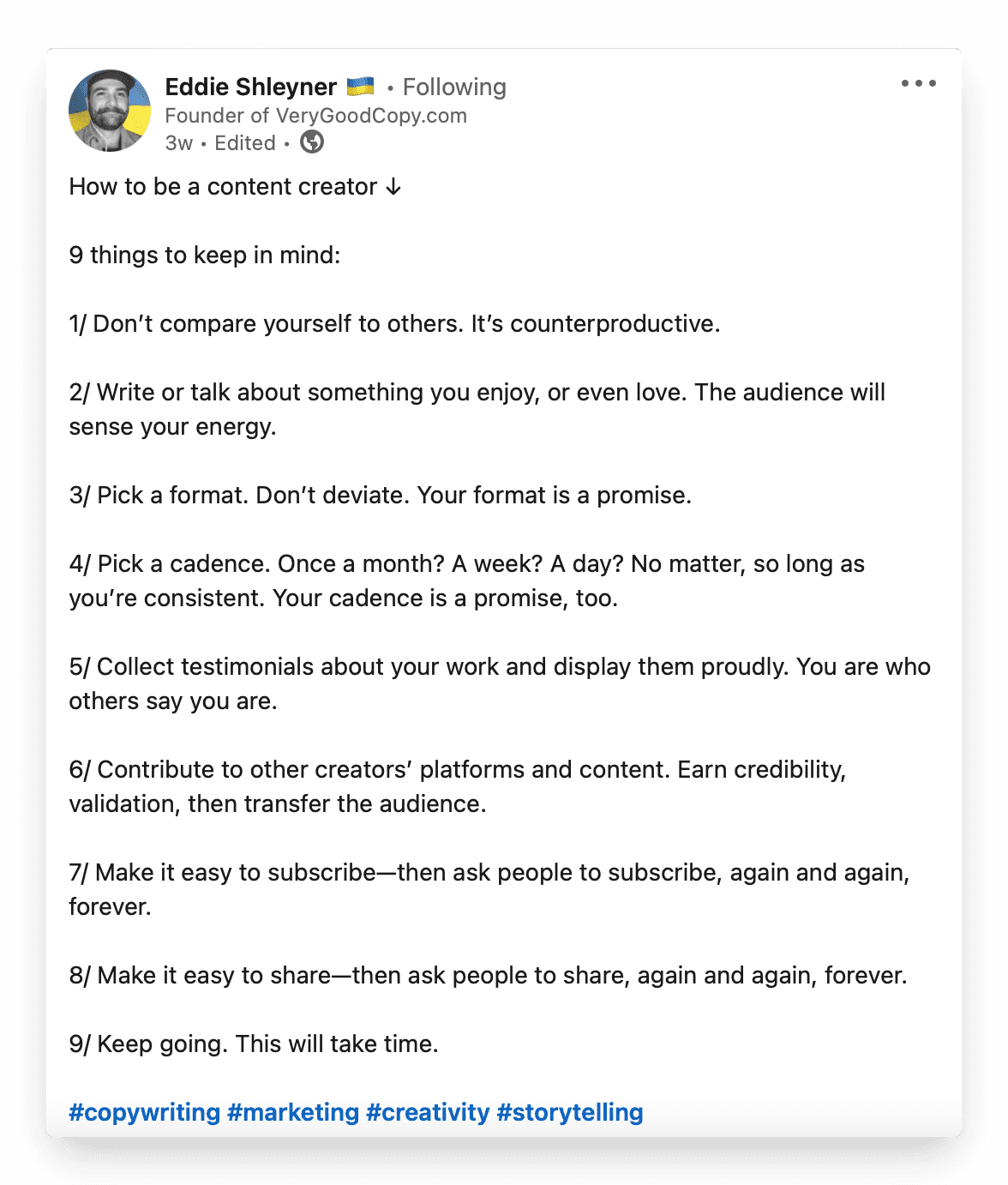
This is a great way to signpost your content’s upside and develop audience trust. Of course, like Eddie does in the above example, be sure to deliver on your promise.
3. An easy-to-agree-with fact
People like to be right. More specifically, people find it easier to connect with others when they have similar opinions and world views to them.
So how does this relate to LinkedIn content writing? Well, let’s take a look at this post by Theo Paphitis to illustrate our point.
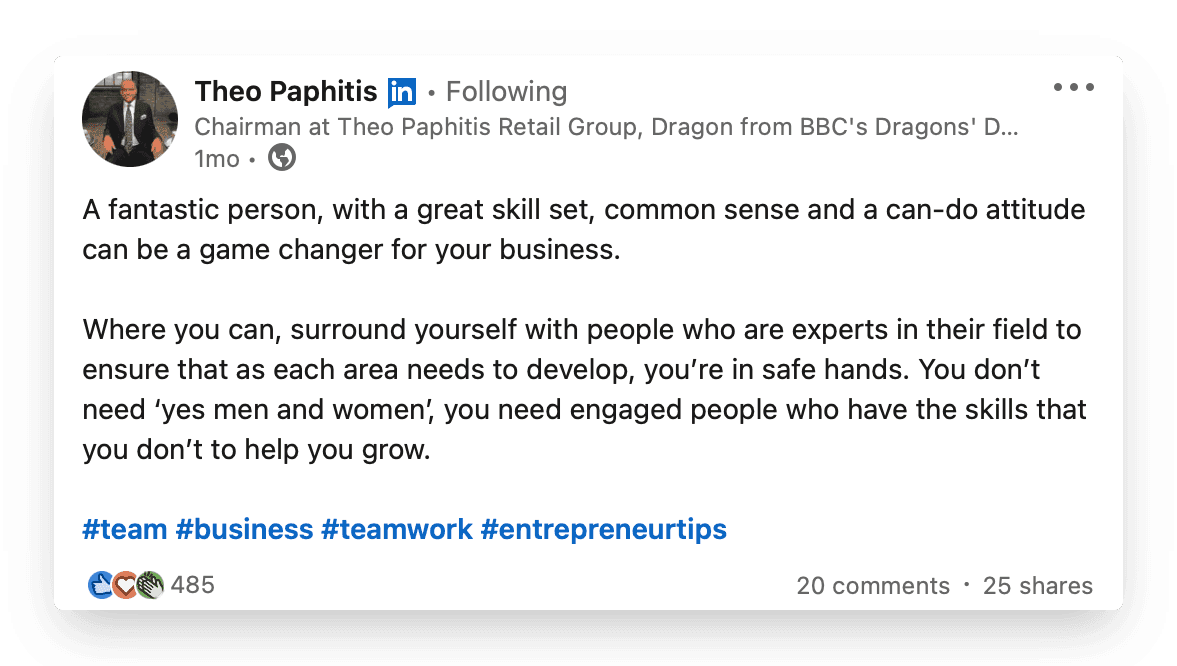
The opening line here breaks down three key elements that make a strong employee - ‘a great skill set, common sense and a can-do attitude’. More than likely, the majority of people scrolling through LinkedIn will agree with the above. As a result, the majority of people who scroll past this post will stop to read it too.
When you’re sitting to write a post, think about some of the indisputable “facts” in your industry. For someone working in finance, for example, perhaps there’s a trending piece of tech that is a game-changer for accounting. Write about it and make a big, flashy, statement about it in your opening line.
‘XYZ tech product has brought FP&A forward for the first time in a decade’.
It’s short, sweet, and invites people to read more.
Bonus points to the eagle-eyed among you who spotted Theo’s use of the ‘Rule of Three’ here too - a great persuasive technique that you can use in your own copywriting.
4. Challenge the status quo
Another great way to make LinkedIn users double-take and stop to read your post is by starting with something that goes against the grain, something that challenges the status quo.
This post by Nick Huber is a great example of something that strays off the beaten path with its ideas as it challenges common pieces of business advice.
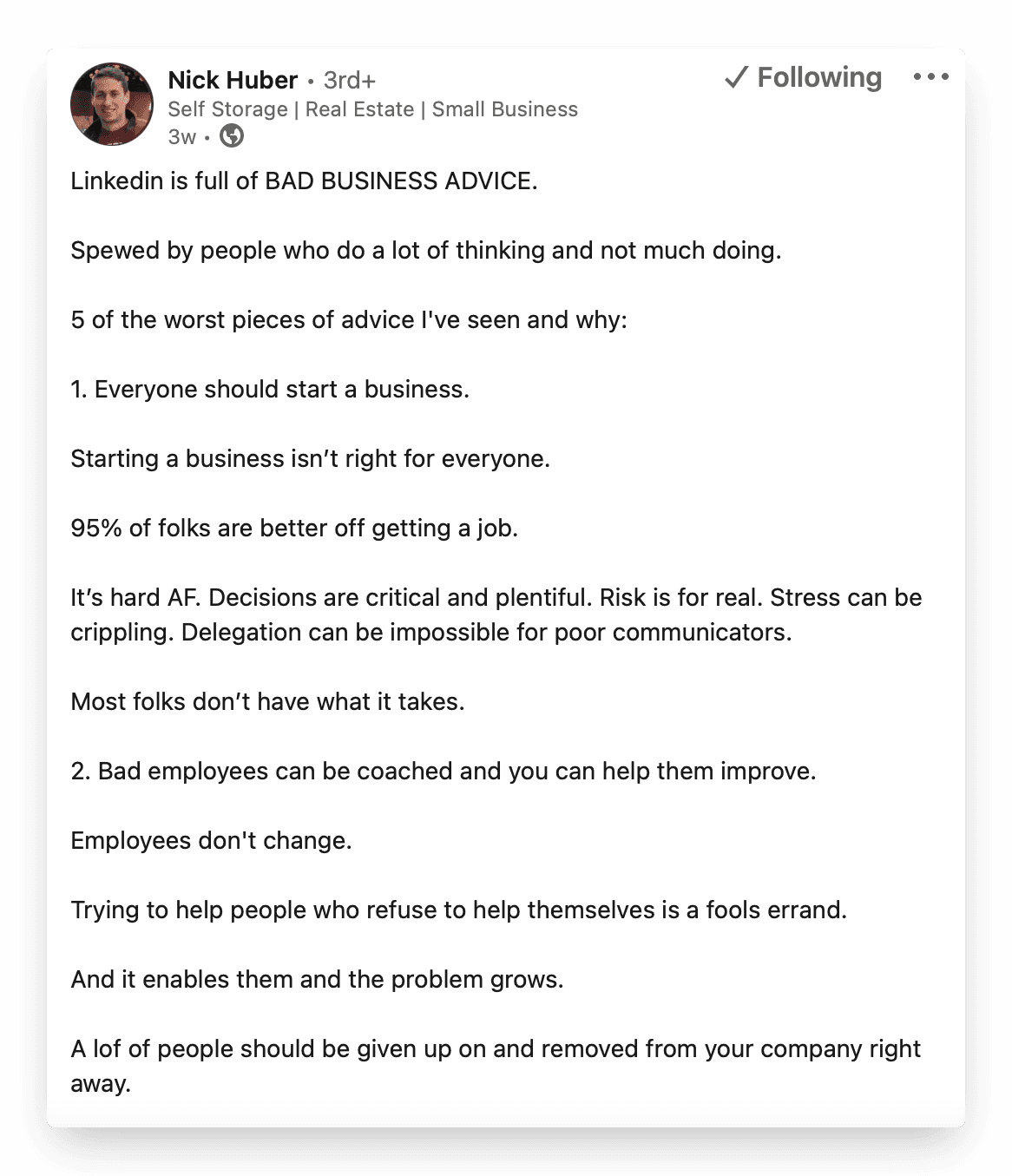
Note how Nick keeps his opening line short, to the point, and capitalises the latter half, all for the sake of emphasis. The way this line is written is just as important as its messaging.
When writing this type of opener, think about some of the widely-accepted “truths” within your industry. For example, in client-facing roles there is the common adage: “The customer is always right”.
If any of you have ever worked in a customer-facing position, you may have gathered that this isn’t always the case. Feed this into your opening line:
“‘The customer is always right’ is a great way to ALIENATE EMPLOYEES.”
It’s blunt, to the point, and is guaranteed to generate chatter in the comments section.
5. Ask a rhetorical question
The approach to writing this type of opener is, by and large, backwards. Start by writing the main body of your post, whether it’s a few lines about your own experiences, some interesting facts, or some sort of story. Consider the main point you would like your audience to consider and distil it into an opening question.
Jennifer Welsh does this particularly well in the below post.
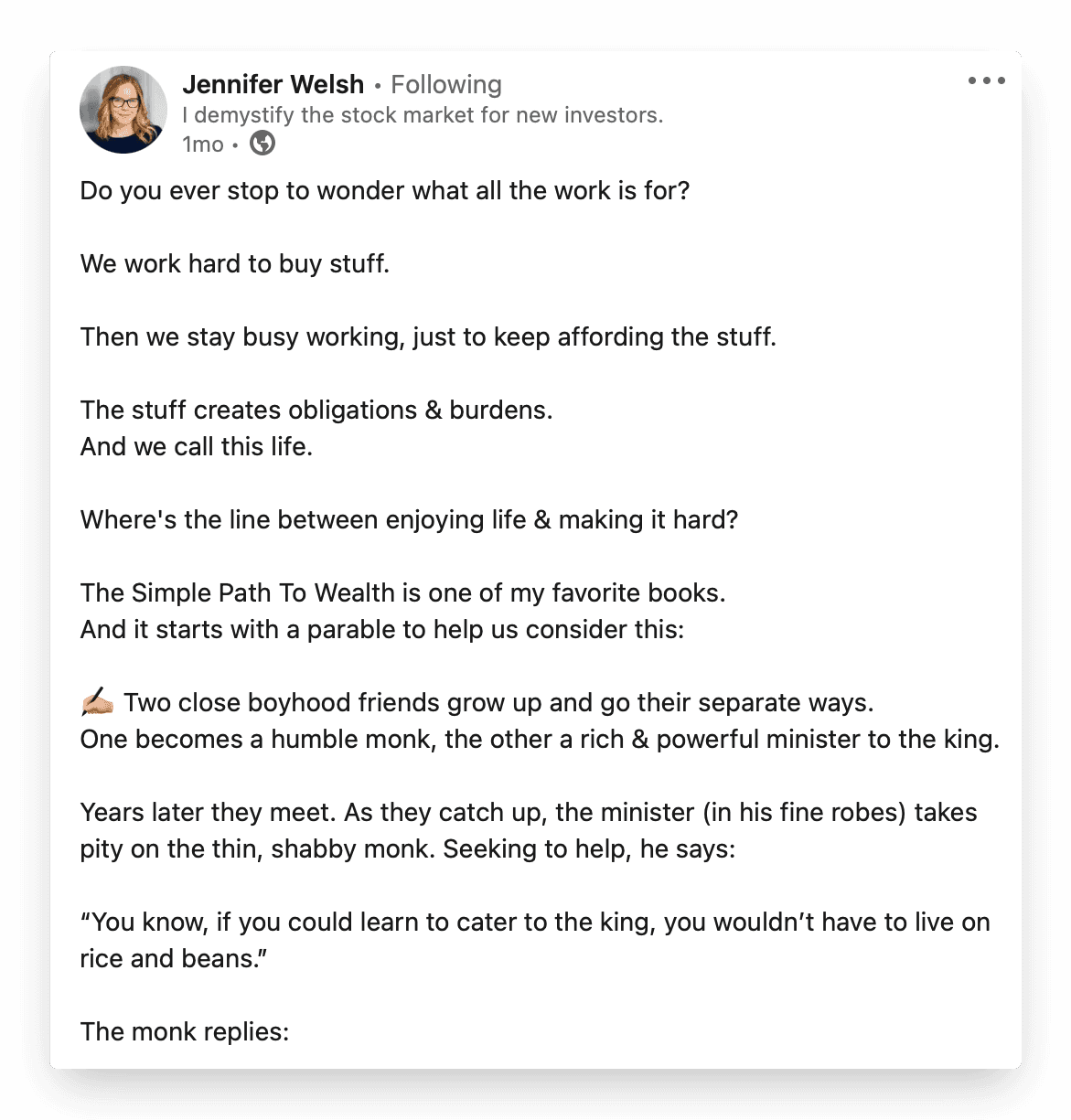
Before we get to the main body of text, we’re encouraged to take a step back and consider the post’s core messaging and how it relates to our own experiences. Fast-forward to the end of the post and you’re bound to have a few opinions on the topic.
6. Bring in your own expertise
A variation of the opening line that promises value, here is a great way to showcase your expertise and give your audience a reason to stop and read your content.
Similar to Pragya’s post below, this opener should start by summarizing what you now know.
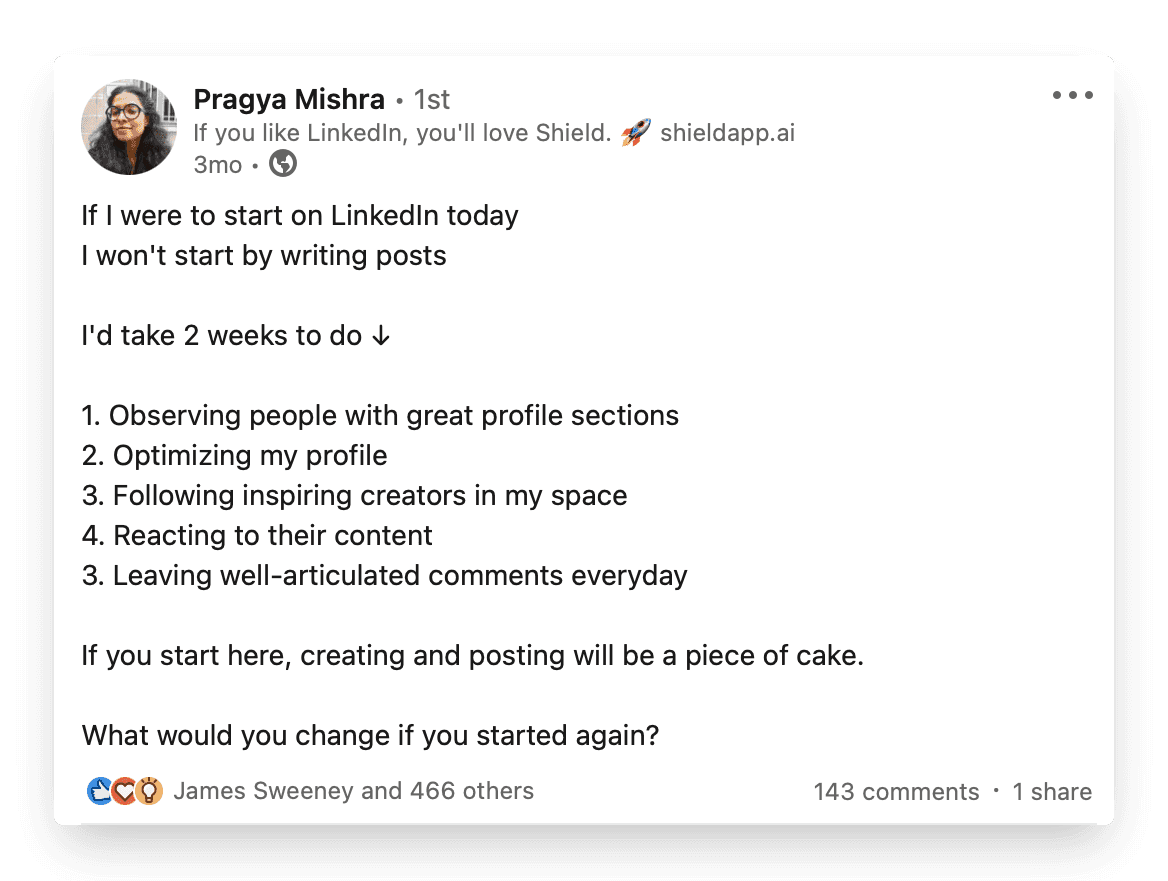
Although Pragya’s first line is ‘If I were to start on LinkedIn today’, what it reads as is: ‘If I were to start on LinkedIn today, with my current level of expertise, I would…’
The post is written from a point of experience, and it’s this showcase that piques a reader’s attention.
Think: How can I flex my know-how in my opening line?
7. Start your post with ‘I’
Aside from any transactional value you can provide, your audience will also be following your content because they are interested in you. Your experiences, opinions and your journey as a whole.
Signpost this post type by opening your copy with personal pronouns, such as “I”.
Like Joe’s Gannon’s post below, ‘I’ posts can be a great way to track milestones, learning experiences and other personal content

8. Announce a change with a story
Continuing with the theme of personal interest, starting your post with an announcement is a great way to generate traction.
Like with Hamza’s post below, the hook for this post type can be an achievement. A promotion, qualification, or personal announcement.
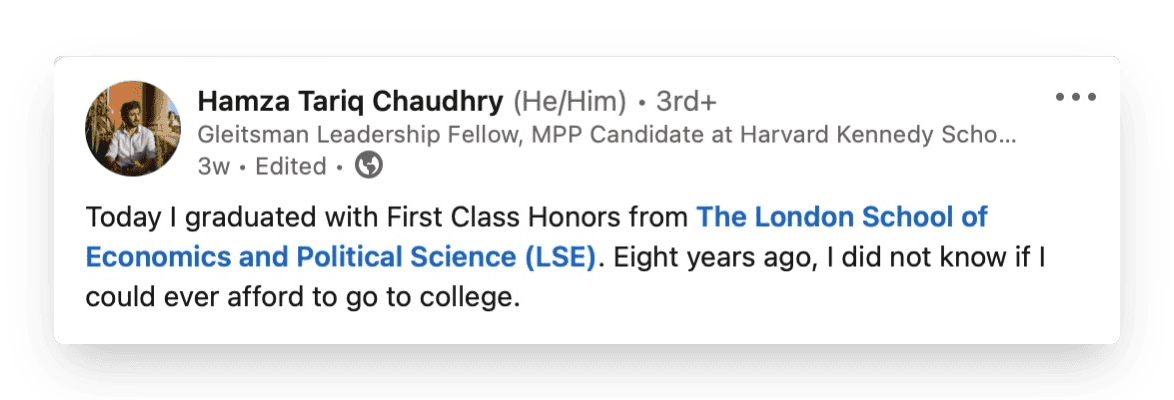
This post-type is an easy win for engagement. After all, LinkedIn auto-generates comment templates to make interacting on this type of content easy.
9. Start with a story
Another way to get people engaged from your opening line: start with a story.
This can be about anything. That time your ten-year old niece’s lemonade stand taught you more about sales than any book ever has, or that time you made a mistake that ultimately changed the course of your career for the better. Anything. Your story doesn’t even have to be real.
What’s important here, as shown in Josh’s post below, is that you don’t waste time with an over-inflated introduction. Dive straight into your story.
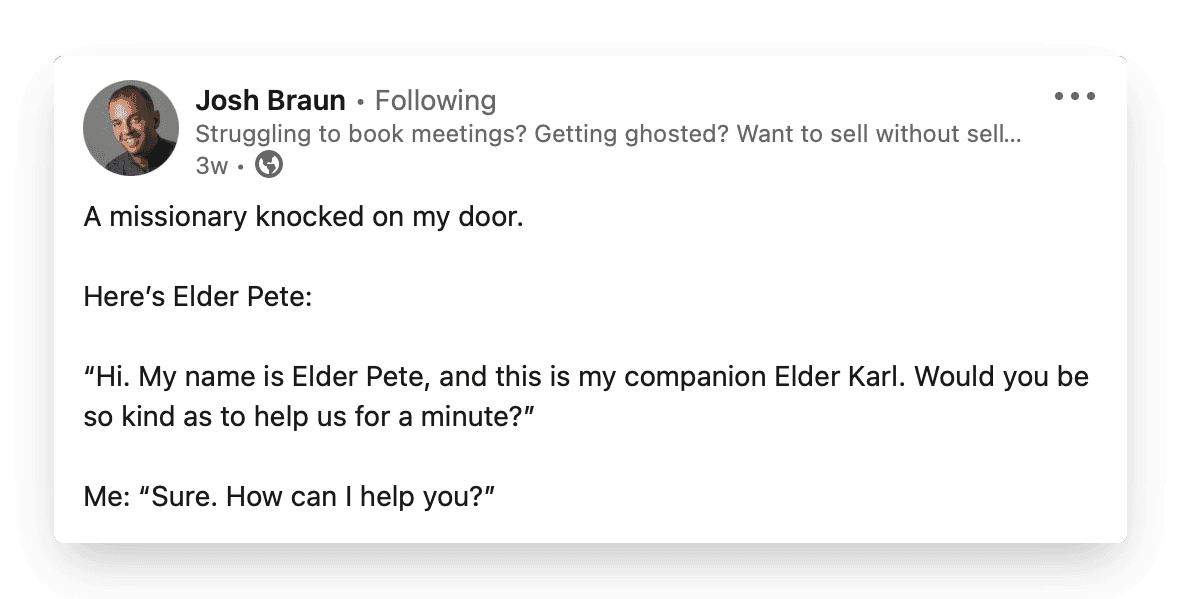
‘A missionary knocked on my door.’
It’s short, abrupt, and leads to more questions than answers. In essence, it makes the reader want to read on.
It certainly caught our attention.
10. Be vulnerable
The benefit of LinkedIn as a platform is that content creators can help debunk different work-related myths.
From Admin Assistants to CEOs, everyone has a voice to share their opinions, experiences and vulnerabilities. Take a look at Andreas’s post below for an example of this in practice.
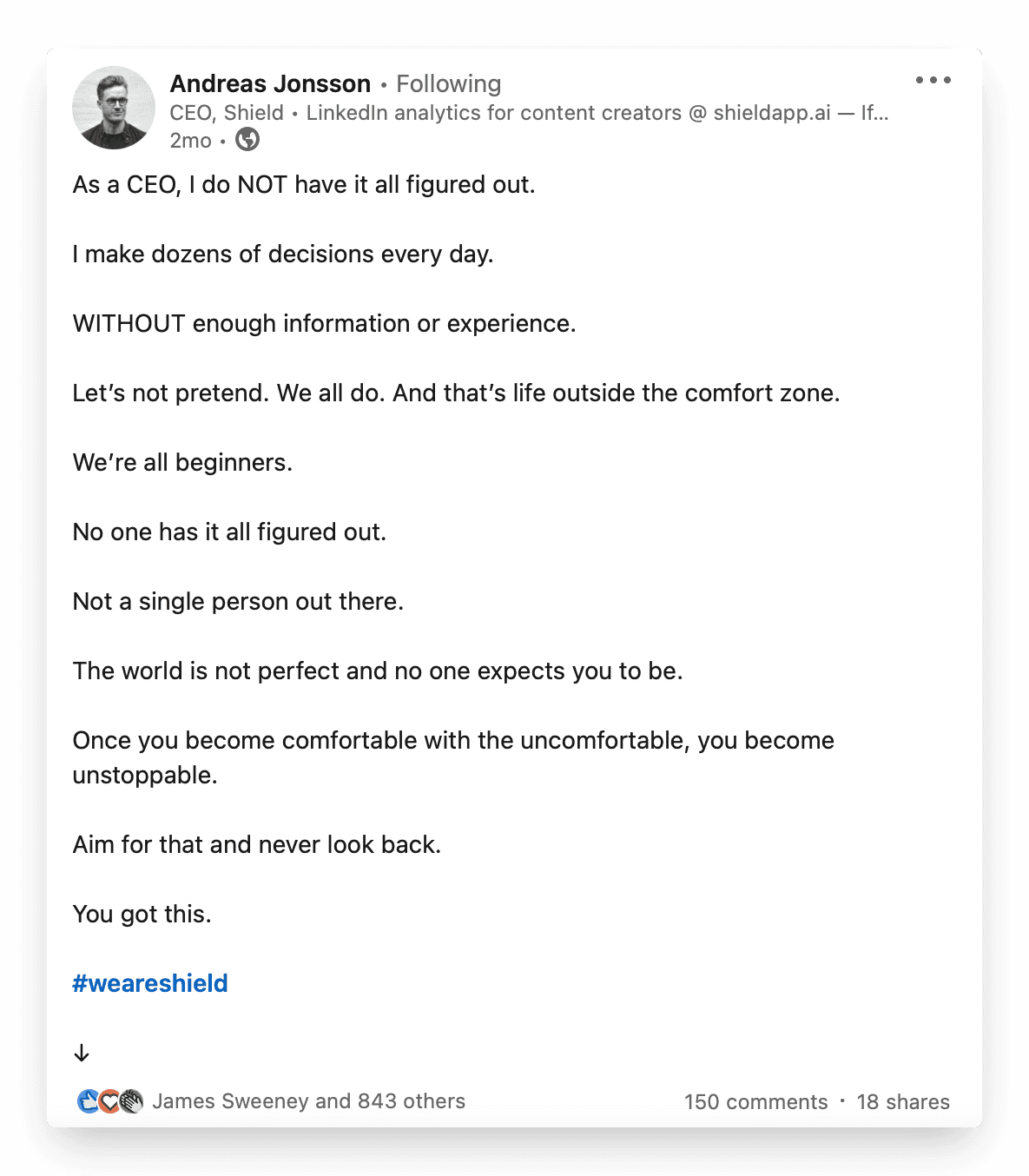
The opener here immediately gets to the point: to demystify a key misconception about CEOs, and leadership as a whole.
Implement this tactic into your own writing. Condense your main messaging into one key “hook” and allow it to lead your post.
Conclusion
Now that we’ve armed you with our top ten LinkedIn opening lines, there’s no excuse to not get some posts written.
Lead with the thought — how can I structure my opener to hook my audience? And then, after this, be sure to deliver on value.
Once you do this your audience will keep coming back.
Joe Gannon x Pragya
If you want more people to read your LinkedIn post then your first line is what you must master.
What determines the success of your content on LinkedIn? Everyone has different measures based on their LinkedIn goals but one thing that's constant is that your audience should actually read your content. And not just scroll past it. So, how do you make sure your audience gets curious with your first line, stops, clicks "...see more" to expand your post and continues reading?
"You write an opening line that hooks your reader to your post. You trigger curiosity and they click “...see more” "
The first line of your post is what decides if you have been able to capture the attention of your audience or not. That is what decides if the reader will actually be curious enough to continue reading.
In this article you will find 10 real examples of posts with great opening lines. Think of these as frameworks and try to test them in your next post.
1. A Big Number
This is the oldest trick in the book.
If you’re looking to get your audience interested in what you have to say, start with providing a “hook”. One of the easiest ways to achieve this: find a relevant and eye-catching statistic that makes your audience stop scrolling.
James Roycroft-Davis applies this with his post below.

Of course, dropping an eye-catching number in your opening line isn’t enough; you’ll need to follow with your opinions, experiences and everything in between to deliver the impact of said number!
2. The "How to Guide”
More often than not, your audience will follow you because of the value you provide, whether that comes in the forms of your expertise, experiences, or something else entirely.
Great. So shine a light on this from the onset. Write an opening line that highlights what your audience is going to gain from your post.
For listicle content like the post below, this is simple case of writing ‘Here’s how to XYZ’.

This is a great way to signpost your content’s upside and develop audience trust. Of course, like Eddie does in the above example, be sure to deliver on your promise.
3. An easy-to-agree-with fact
People like to be right. More specifically, people find it easier to connect with others when they have similar opinions and world views to them.
So how does this relate to LinkedIn content writing? Well, let’s take a look at this post by Theo Paphitis to illustrate our point.

The opening line here breaks down three key elements that make a strong employee - ‘a great skill set, common sense and a can-do attitude’. More than likely, the majority of people scrolling through LinkedIn will agree with the above. As a result, the majority of people who scroll past this post will stop to read it too.
When you’re sitting to write a post, think about some of the indisputable “facts” in your industry. For someone working in finance, for example, perhaps there’s a trending piece of tech that is a game-changer for accounting. Write about it and make a big, flashy, statement about it in your opening line.
‘XYZ tech product has brought FP&A forward for the first time in a decade’.
It’s short, sweet, and invites people to read more.
Bonus points to the eagle-eyed among you who spotted Theo’s use of the ‘Rule of Three’ here too - a great persuasive technique that you can use in your own copywriting.
4. Challenge the status quo
Another great way to make LinkedIn users double-take and stop to read your post is by starting with something that goes against the grain, something that challenges the status quo.
This post by Nick Huber is a great example of something that strays off the beaten path with its ideas as it challenges common pieces of business advice.

Note how Nick keeps his opening line short, to the point, and capitalises the latter half, all for the sake of emphasis. The way this line is written is just as important as its messaging.
When writing this type of opener, think about some of the widely-accepted “truths” within your industry. For example, in client-facing roles there is the common adage: “The customer is always right”.
If any of you have ever worked in a customer-facing position, you may have gathered that this isn’t always the case. Feed this into your opening line:
“‘The customer is always right’ is a great way to ALIENATE EMPLOYEES.”
It’s blunt, to the point, and is guaranteed to generate chatter in the comments section.
5. Ask a rhetorical question
The approach to writing this type of opener is, by and large, backwards. Start by writing the main body of your post, whether it’s a few lines about your own experiences, some interesting facts, or some sort of story. Consider the main point you would like your audience to consider and distil it into an opening question.
Jennifer Welsh does this particularly well in the below post.

Before we get to the main body of text, we’re encouraged to take a step back and consider the post’s core messaging and how it relates to our own experiences. Fast-forward to the end of the post and you’re bound to have a few opinions on the topic.
6. Bring in your own expertise
A variation of the opening line that promises value, here is a great way to showcase your expertise and give your audience a reason to stop and read your content.
Similar to Pragya’s post below, this opener should start by summarizing what you now know.

Although Pragya’s first line is ‘If I were to start on LinkedIn today’, what it reads as is: ‘If I were to start on LinkedIn today, with my current level of expertise, I would…’
The post is written from a point of experience, and it’s this showcase that piques a reader’s attention.
Think: How can I flex my know-how in my opening line?
7. Start your post with ‘I’
Aside from any transactional value you can provide, your audience will also be following your content because they are interested in you. Your experiences, opinions and your journey as a whole.
Signpost this post type by opening your copy with personal pronouns, such as “I”.
Like Joe’s Gannon’s post below, ‘I’ posts can be a great way to track milestones, learning experiences and other personal content

8. Announce a change with a story
Continuing with the theme of personal interest, starting your post with an announcement is a great way to generate traction.
Like with Hamza’s post below, the hook for this post type can be an achievement. A promotion, qualification, or personal announcement.

This post-type is an easy win for engagement. After all, LinkedIn auto-generates comment templates to make interacting on this type of content easy.
9. Start with a story
Another way to get people engaged from your opening line: start with a story.
This can be about anything. That time your ten-year old niece’s lemonade stand taught you more about sales than any book ever has, or that time you made a mistake that ultimately changed the course of your career for the better. Anything. Your story doesn’t even have to be real.
What’s important here, as shown in Josh’s post below, is that you don’t waste time with an over-inflated introduction. Dive straight into your story.

‘A missionary knocked on my door.’
It’s short, abrupt, and leads to more questions than answers. In essence, it makes the reader want to read on.
It certainly caught our attention.
10. Be vulnerable
The benefit of LinkedIn as a platform is that content creators can help debunk different work-related myths.
From Admin Assistants to CEOs, everyone has a voice to share their opinions, experiences and vulnerabilities. Take a look at Andreas’s post below for an example of this in practice.

The opener here immediately gets to the point: to demystify a key misconception about CEOs, and leadership as a whole.
Implement this tactic into your own writing. Condense your main messaging into one key “hook” and allow it to lead your post.
Conclusion
Now that we’ve armed you with our top ten LinkedIn opening lines, there’s no excuse to not get some posts written.
Lead with the thought — how can I structure my opener to hook my audience? And then, after this, be sure to deliver on value.
Once you do this your audience will keep coming back.
Joe Gannon x Pragya
If you want more people to read your LinkedIn post then your first line is what you must master.
What determines the success of your content on LinkedIn? Everyone has different measures based on their LinkedIn goals but one thing that's constant is that your audience should actually read your content. And not just scroll past it. So, how do you make sure your audience gets curious with your first line, stops, clicks "...see more" to expand your post and continues reading?
"You write an opening line that hooks your reader to your post. You trigger curiosity and they click “...see more” "
The first line of your post is what decides if you have been able to capture the attention of your audience or not. That is what decides if the reader will actually be curious enough to continue reading.
In this article you will find 10 real examples of posts with great opening lines. Think of these as frameworks and try to test them in your next post.
1. A Big Number
This is the oldest trick in the book.
If you’re looking to get your audience interested in what you have to say, start with providing a “hook”. One of the easiest ways to achieve this: find a relevant and eye-catching statistic that makes your audience stop scrolling.
James Roycroft-Davis applies this with his post below.

Of course, dropping an eye-catching number in your opening line isn’t enough; you’ll need to follow with your opinions, experiences and everything in between to deliver the impact of said number!
2. The "How to Guide”
More often than not, your audience will follow you because of the value you provide, whether that comes in the forms of your expertise, experiences, or something else entirely.
Great. So shine a light on this from the onset. Write an opening line that highlights what your audience is going to gain from your post.
For listicle content like the post below, this is simple case of writing ‘Here’s how to XYZ’.

This is a great way to signpost your content’s upside and develop audience trust. Of course, like Eddie does in the above example, be sure to deliver on your promise.
3. An easy-to-agree-with fact
People like to be right. More specifically, people find it easier to connect with others when they have similar opinions and world views to them.
So how does this relate to LinkedIn content writing? Well, let’s take a look at this post by Theo Paphitis to illustrate our point.

The opening line here breaks down three key elements that make a strong employee - ‘a great skill set, common sense and a can-do attitude’. More than likely, the majority of people scrolling through LinkedIn will agree with the above. As a result, the majority of people who scroll past this post will stop to read it too.
When you’re sitting to write a post, think about some of the indisputable “facts” in your industry. For someone working in finance, for example, perhaps there’s a trending piece of tech that is a game-changer for accounting. Write about it and make a big, flashy, statement about it in your opening line.
‘XYZ tech product has brought FP&A forward for the first time in a decade’.
It’s short, sweet, and invites people to read more.
Bonus points to the eagle-eyed among you who spotted Theo’s use of the ‘Rule of Three’ here too - a great persuasive technique that you can use in your own copywriting.
4. Challenge the status quo
Another great way to make LinkedIn users double-take and stop to read your post is by starting with something that goes against the grain, something that challenges the status quo.
This post by Nick Huber is a great example of something that strays off the beaten path with its ideas as it challenges common pieces of business advice.

Note how Nick keeps his opening line short, to the point, and capitalises the latter half, all for the sake of emphasis. The way this line is written is just as important as its messaging.
When writing this type of opener, think about some of the widely-accepted “truths” within your industry. For example, in client-facing roles there is the common adage: “The customer is always right”.
If any of you have ever worked in a customer-facing position, you may have gathered that this isn’t always the case. Feed this into your opening line:
“‘The customer is always right’ is a great way to ALIENATE EMPLOYEES.”
It’s blunt, to the point, and is guaranteed to generate chatter in the comments section.
5. Ask a rhetorical question
The approach to writing this type of opener is, by and large, backwards. Start by writing the main body of your post, whether it’s a few lines about your own experiences, some interesting facts, or some sort of story. Consider the main point you would like your audience to consider and distil it into an opening question.
Jennifer Welsh does this particularly well in the below post.

Before we get to the main body of text, we’re encouraged to take a step back and consider the post’s core messaging and how it relates to our own experiences. Fast-forward to the end of the post and you’re bound to have a few opinions on the topic.
6. Bring in your own expertise
A variation of the opening line that promises value, here is a great way to showcase your expertise and give your audience a reason to stop and read your content.
Similar to Pragya’s post below, this opener should start by summarizing what you now know.

Although Pragya’s first line is ‘If I were to start on LinkedIn today’, what it reads as is: ‘If I were to start on LinkedIn today, with my current level of expertise, I would…’
The post is written from a point of experience, and it’s this showcase that piques a reader’s attention.
Think: How can I flex my know-how in my opening line?
7. Start your post with ‘I’
Aside from any transactional value you can provide, your audience will also be following your content because they are interested in you. Your experiences, opinions and your journey as a whole.
Signpost this post type by opening your copy with personal pronouns, such as “I”.
Like Joe’s Gannon’s post below, ‘I’ posts can be a great way to track milestones, learning experiences and other personal content

8. Announce a change with a story
Continuing with the theme of personal interest, starting your post with an announcement is a great way to generate traction.
Like with Hamza’s post below, the hook for this post type can be an achievement. A promotion, qualification, or personal announcement.

This post-type is an easy win for engagement. After all, LinkedIn auto-generates comment templates to make interacting on this type of content easy.
9. Start with a story
Another way to get people engaged from your opening line: start with a story.
This can be about anything. That time your ten-year old niece’s lemonade stand taught you more about sales than any book ever has, or that time you made a mistake that ultimately changed the course of your career for the better. Anything. Your story doesn’t even have to be real.
What’s important here, as shown in Josh’s post below, is that you don’t waste time with an over-inflated introduction. Dive straight into your story.

‘A missionary knocked on my door.’
It’s short, abrupt, and leads to more questions than answers. In essence, it makes the reader want to read on.
It certainly caught our attention.
10. Be vulnerable
The benefit of LinkedIn as a platform is that content creators can help debunk different work-related myths.
From Admin Assistants to CEOs, everyone has a voice to share their opinions, experiences and vulnerabilities. Take a look at Andreas’s post below for an example of this in practice.

The opener here immediately gets to the point: to demystify a key misconception about CEOs, and leadership as a whole.
Implement this tactic into your own writing. Condense your main messaging into one key “hook” and allow it to lead your post.
Conclusion
Now that we’ve armed you with our top ten LinkedIn opening lines, there’s no excuse to not get some posts written.
Lead with the thought — how can I structure my opener to hook my audience? And then, after this, be sure to deliver on value.
Once you do this your audience will keep coming back.
Joe Gannon x Pragya
If you want more people to read your LinkedIn post then your first line is what you must master.
What determines the success of your content on LinkedIn? Everyone has different measures based on their LinkedIn goals but one thing that's constant is that your audience should actually read your content. And not just scroll past it. So, how do you make sure your audience gets curious with your first line, stops, clicks "...see more" to expand your post and continues reading?
"You write an opening line that hooks your reader to your post. You trigger curiosity and they click “...see more” "
The first line of your post is what decides if you have been able to capture the attention of your audience or not. That is what decides if the reader will actually be curious enough to continue reading.
In this article you will find 10 real examples of posts with great opening lines. Think of these as frameworks and try to test them in your next post.
1. A Big Number
This is the oldest trick in the book.
If you’re looking to get your audience interested in what you have to say, start with providing a “hook”. One of the easiest ways to achieve this: find a relevant and eye-catching statistic that makes your audience stop scrolling.
James Roycroft-Davis applies this with his post below.

Of course, dropping an eye-catching number in your opening line isn’t enough; you’ll need to follow with your opinions, experiences and everything in between to deliver the impact of said number!
2. The "How to Guide”
More often than not, your audience will follow you because of the value you provide, whether that comes in the forms of your expertise, experiences, or something else entirely.
Great. So shine a light on this from the onset. Write an opening line that highlights what your audience is going to gain from your post.
For listicle content like the post below, this is simple case of writing ‘Here’s how to XYZ’.

This is a great way to signpost your content’s upside and develop audience trust. Of course, like Eddie does in the above example, be sure to deliver on your promise.
3. An easy-to-agree-with fact
People like to be right. More specifically, people find it easier to connect with others when they have similar opinions and world views to them.
So how does this relate to LinkedIn content writing? Well, let’s take a look at this post by Theo Paphitis to illustrate our point.

The opening line here breaks down three key elements that make a strong employee - ‘a great skill set, common sense and a can-do attitude’. More than likely, the majority of people scrolling through LinkedIn will agree with the above. As a result, the majority of people who scroll past this post will stop to read it too.
When you’re sitting to write a post, think about some of the indisputable “facts” in your industry. For someone working in finance, for example, perhaps there’s a trending piece of tech that is a game-changer for accounting. Write about it and make a big, flashy, statement about it in your opening line.
‘XYZ tech product has brought FP&A forward for the first time in a decade’.
It’s short, sweet, and invites people to read more.
Bonus points to the eagle-eyed among you who spotted Theo’s use of the ‘Rule of Three’ here too - a great persuasive technique that you can use in your own copywriting.
4. Challenge the status quo
Another great way to make LinkedIn users double-take and stop to read your post is by starting with something that goes against the grain, something that challenges the status quo.
This post by Nick Huber is a great example of something that strays off the beaten path with its ideas as it challenges common pieces of business advice.

Note how Nick keeps his opening line short, to the point, and capitalises the latter half, all for the sake of emphasis. The way this line is written is just as important as its messaging.
When writing this type of opener, think about some of the widely-accepted “truths” within your industry. For example, in client-facing roles there is the common adage: “The customer is always right”.
If any of you have ever worked in a customer-facing position, you may have gathered that this isn’t always the case. Feed this into your opening line:
“‘The customer is always right’ is a great way to ALIENATE EMPLOYEES.”
It’s blunt, to the point, and is guaranteed to generate chatter in the comments section.
5. Ask a rhetorical question
The approach to writing this type of opener is, by and large, backwards. Start by writing the main body of your post, whether it’s a few lines about your own experiences, some interesting facts, or some sort of story. Consider the main point you would like your audience to consider and distil it into an opening question.
Jennifer Welsh does this particularly well in the below post.

Before we get to the main body of text, we’re encouraged to take a step back and consider the post’s core messaging and how it relates to our own experiences. Fast-forward to the end of the post and you’re bound to have a few opinions on the topic.
6. Bring in your own expertise
A variation of the opening line that promises value, here is a great way to showcase your expertise and give your audience a reason to stop and read your content.
Similar to Pragya’s post below, this opener should start by summarizing what you now know.

Although Pragya’s first line is ‘If I were to start on LinkedIn today’, what it reads as is: ‘If I were to start on LinkedIn today, with my current level of expertise, I would…’
The post is written from a point of experience, and it’s this showcase that piques a reader’s attention.
Think: How can I flex my know-how in my opening line?
7. Start your post with ‘I’
Aside from any transactional value you can provide, your audience will also be following your content because they are interested in you. Your experiences, opinions and your journey as a whole.
Signpost this post type by opening your copy with personal pronouns, such as “I”.
Like Joe’s Gannon’s post below, ‘I’ posts can be a great way to track milestones, learning experiences and other personal content

8. Announce a change with a story
Continuing with the theme of personal interest, starting your post with an announcement is a great way to generate traction.
Like with Hamza’s post below, the hook for this post type can be an achievement. A promotion, qualification, or personal announcement.

This post-type is an easy win for engagement. After all, LinkedIn auto-generates comment templates to make interacting on this type of content easy.
9. Start with a story
Another way to get people engaged from your opening line: start with a story.
This can be about anything. That time your ten-year old niece’s lemonade stand taught you more about sales than any book ever has, or that time you made a mistake that ultimately changed the course of your career for the better. Anything. Your story doesn’t even have to be real.
What’s important here, as shown in Josh’s post below, is that you don’t waste time with an over-inflated introduction. Dive straight into your story.

‘A missionary knocked on my door.’
It’s short, abrupt, and leads to more questions than answers. In essence, it makes the reader want to read on.
It certainly caught our attention.
10. Be vulnerable
The benefit of LinkedIn as a platform is that content creators can help debunk different work-related myths.
From Admin Assistants to CEOs, everyone has a voice to share their opinions, experiences and vulnerabilities. Take a look at Andreas’s post below for an example of this in practice.

The opener here immediately gets to the point: to demystify a key misconception about CEOs, and leadership as a whole.
Implement this tactic into your own writing. Condense your main messaging into one key “hook” and allow it to lead your post.
Conclusion
Now that we’ve armed you with our top ten LinkedIn opening lines, there’s no excuse to not get some posts written.
Lead with the thought — how can I structure my opener to hook my audience? And then, after this, be sure to deliver on value.
Once you do this your audience will keep coming back.
Joe Gannon x Pragya


